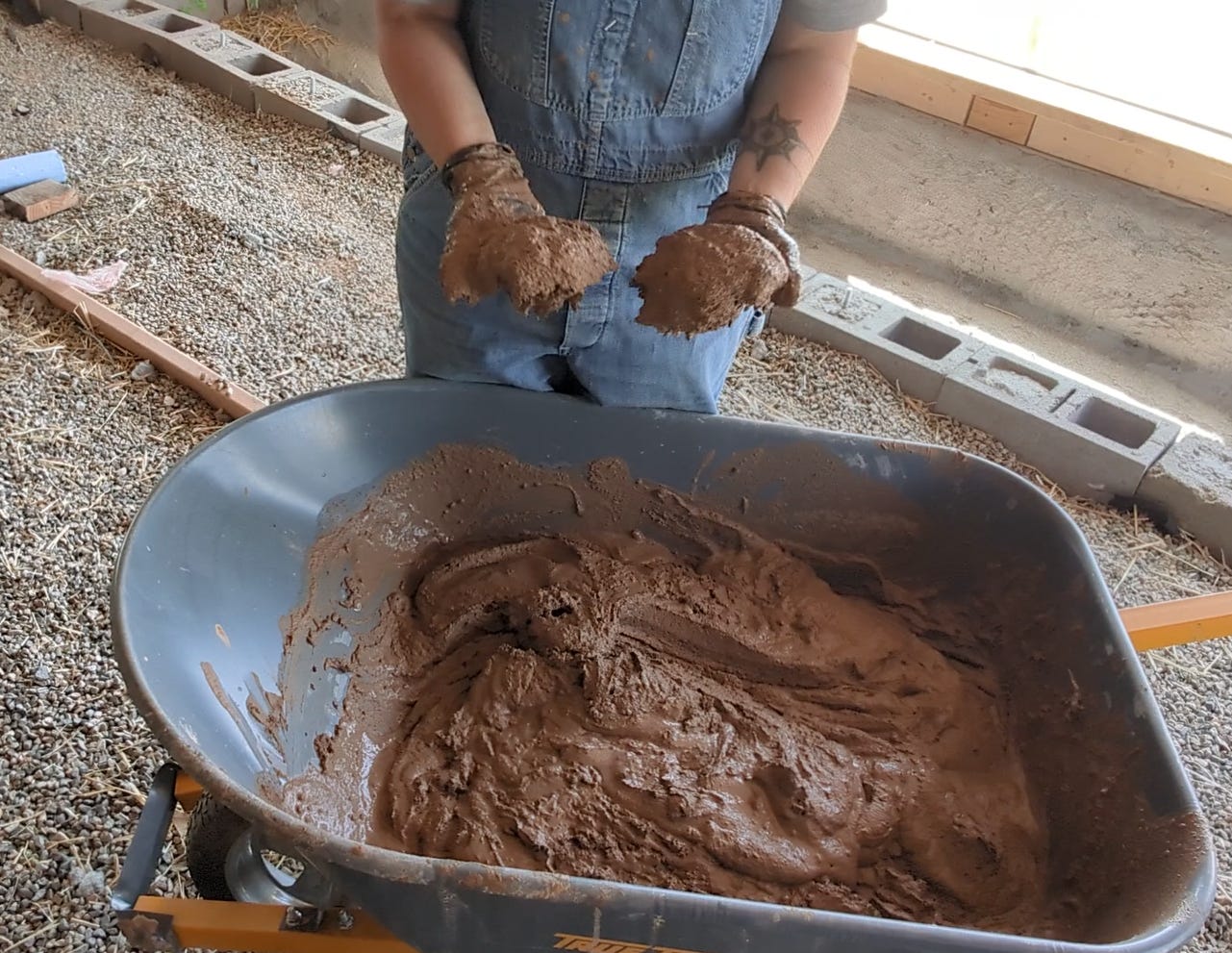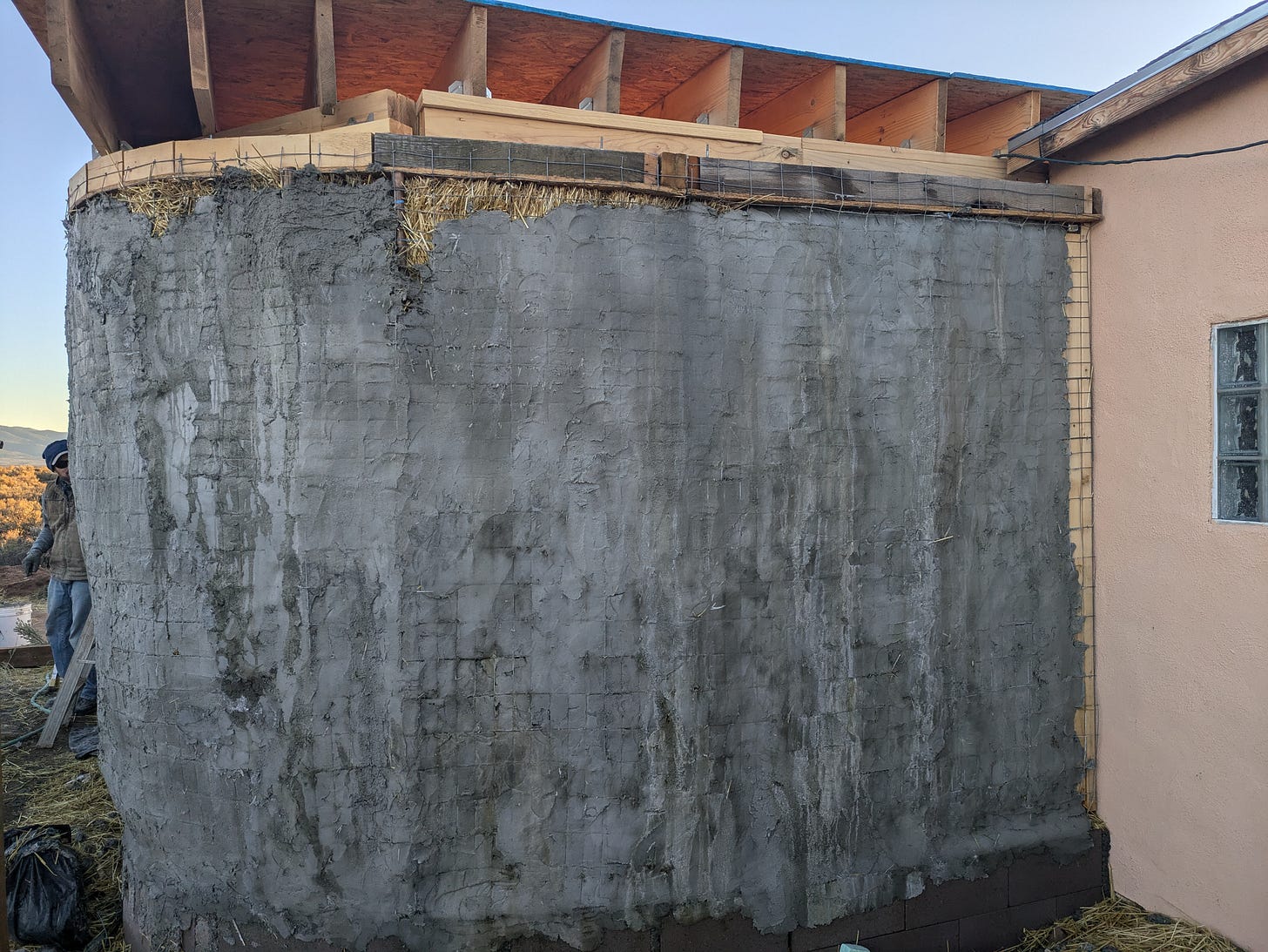Mud is Only Temporary, Just Like You.
Ruminating on chemistry, construction and the eternal struggle against bondage in a world full of gross binders.
I had an illuminating moment while playing in the mud over the weekend. It’s going to take a moment to shine that light, bare with me.
See, the new attached greenhouse, living and office space for our straw bale home has two very different finishes on its outside and inside. The outside-facing side of the bales is covered in cement stucco for maximum weather resistance (and to match the rest of the home), while the inside will be covered in a natural mud clay mix from dirt drawn from the same property just a few paces away.
This past week we’ve been spending time applying a simple clay slip of sifted dirt and water, otherwise known to children everywhere as mud.
The processes for applying stucco or mud can appear to be nearly identical: simply combine the base material (either clay dirt or cement stucco mix) with some water and sand, stir and slap on the wall — we find that literally slapping handfuls on with some gloves works best.
While the steps are similar, the actual experiences of spending a day wrist-deep (at least) in clay versus cement stucco are worlds apart. It took a while for me to recognize the difference on a conscious level.
A Tale of Different Bonds
Days spent with stucco aren’t too bad, but they require some thought and energy for prep and clean up because of the caustic nature of cement. It’s particularly rough on lungs, eyes, skin and pretty much all other biological tissue, and of course it becomes difficult to deal with when it hardens.
This shouldn’t be surprising. Cement, after all, is used to create artificial barriers or structure to separate us from the natural elements. Chemically, it’s a binder that acts as a sort of glue between other materials like sand, gravel or even fibers to create a new, hard material. In the most basic terms, add water to cement and a chemical reaction is set in motion that allows the substance to glom on to anything it touches to essentially create stone.
The thing about working with mud is that it lacks such a strong, permanent binding agent. The bonds between water and dirt that form a nice mud are much weaker, and most importantly, they are far more temporary. When your mud dries out completely it reverts back to being dirt, perhaps in as little as a few hours.
There’s a joy and a freedom to working with clay mud that just isn’t there when working with cement stucco. I can think of several explanations for this ranging from obvious to not so much.
First, cement is just toxic stuff. Surprisingly so. The first time my gloves failed me and I spent hours essentially soaking my hands in wet stucco led to days of unpleasant, insatiably dry skin afterwards as the chemical reaction played out on my epidermis, sucking up all its moisture and even doing a little temporary damage to the protective layer of my hands. Johanna had it worse with what seemed to be minor chemical burns.
Mud, on the other hand, is one of the earliest playthings many of us experience. Well into adulthood, the result of a rainstorm on a patch of dirt can be memorable, especially if you’ve got four-wheel drive and nowhere else to be.
Mud clearly has a more primal and natural appeal compared to the repellant poison present in cement.
But, in reality, it’s not really fair to draw a comparison between mud and cement, as they’re really apples and oranges. Cement, as I’ve explained is just a binder meant to create a new and permanent substance, whereas mud is more a temporary suspension of water, dirt and whatever other material might be present.
Binders Full of Yuck
There are a number of other binders out there that are often used in conjunction with mud to make it more strong, durable and comparable to a permanent material like stucco. These binders tend to be more natural and less toxic than cement, but what’s interesting is that they’re still generally pretty unpleasant to work with.
The most popular non-cement binder is lime, derived from limestone, which actually can be toxic and acts in much the same way as cement (lime is a primary ingredient in cement). Other natural binders include dung, asphalt/bitumen or milk casein.
None of these substances are things I want to get wrist deep in for long, whereas stirring up a batch of plain old dirt and water clay slip in our wheel barrow with my bare hands is actually fun.
It got me thinking that there might be more going on than the obvious tendency towards the naturalistic and nostalgic qualities of mud over the industrial artificiality of cement and stucco.
Dust to Dust, Not Cement
What if the real primal aversion at play here is to binders, or more specifically to the permanence that they enable?
There’s a certain stress to dealing with a batch of stucco - you only get one shot at putting that batch to use, it needs to be used before it dries up and you need to use up the whole batch in one go or it will be wasted (it’s very difficult to keep cement from starting to set up if you walk away from it for long). And of course, once it does set up, it can be very difficult to modify or remove it.
All of this is the fault of the binder (cement), whereas the clay slip I’ve been working with (just mud with no binder added) can be easily reversed; either left to dry up and brushed off after a long while or hosed away.
So the question is: is my affection for mud really about a primal connection to the soil, or nostalgia for splashing and squishing handfuls of muck, ill-advised mudding adventures in rain-soaked Alaskan sloughs? OR, is it a preference for a more temporal state and a fear of the permanent and irreversible commitment represented by lime-based binders seeking to turn everything, perhaps even us, back to stone to be buried and forgotten?
There’s plenty in the preceding paragraph for any armchair psychoanalyst to diagnose me with some sort of pathology. Bring it on. You’ll probably be right. But I submit that being bound up permanently isn’t an experience that many of us aspire to. Prison is a punishment for a reason, after all.
Of course, the clay slip I’m working with now is just a base layer. At some point we’ll start adding some binders to our mud in the form of wheat paste (notably more pleasant than the aforementioned options, but still not something to soak your hands in) that will be less hard, strong and durable than the industrial bonds created by cement. Perhaps it’s just the right compromise for my particular pathology.



